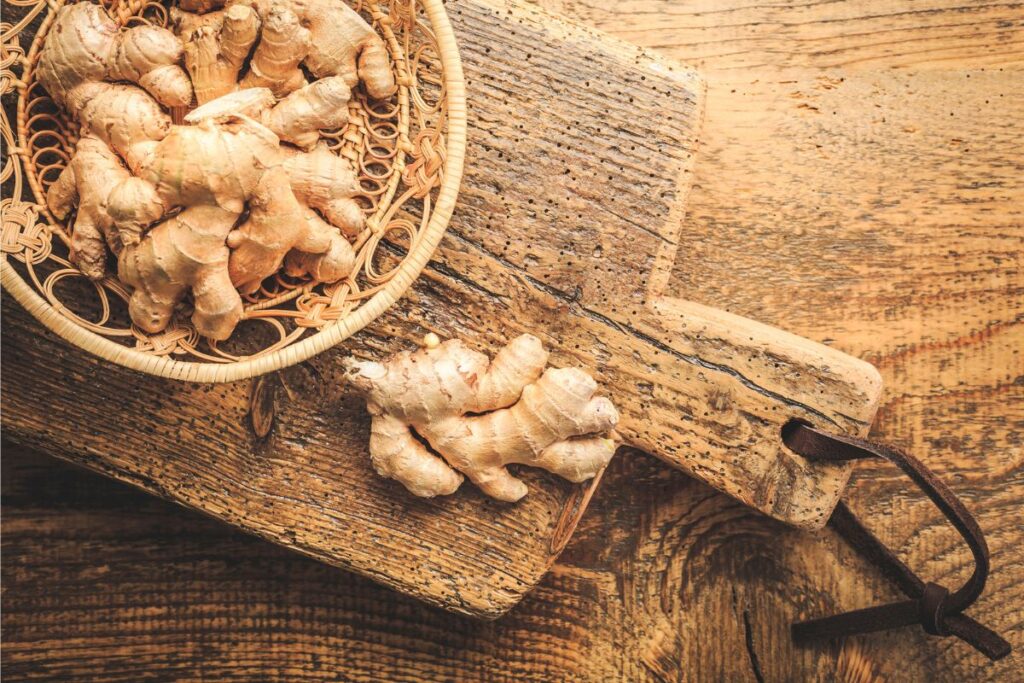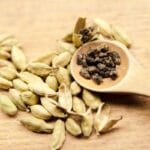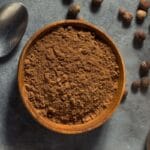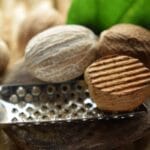Quick summary: Fresh ginger can be replaced by turmeric, ginseng, allspice, mace, cardamom, and even cinnamon. There are plenty of creative ideas to replace ginger for all your salty, sweet, or juicy creations.
Also known as ginger root, fresh ginger is an incredibly versatile ingredient that can bring warming comfort, a spicy kick, and a burst of freshness depending on how it is used. It brings a punch of flavor to sweet and savory dishes from curry and stir fry to ginger beer, warm baked puddings, and cookies.
Whether you’re making fresh juice, gingerbread cookies, or a hearty winter soup, there is nothing that will replicate the flavor exactly, but there is a range of substitutes that come close.
In this guide, we’ll help you figure out how to use dried or candied ginger instead of the fresh root and which alternatives can be used when you’re entirely out of stock.
Ginger Properties
The root grows in irregular chunky shapes with a thin light brown outer skin and fibrous, yellow flesh. It is praised for its great health benefits, from boosting immunity to treating nausea. It can be steeped to make tea, juiced, pickled, candied, dried, and used freshly chopped or grated.
Ginger pairs well with seafood, pork, chicken, beef, and vegetable dishes. In desserts, it’s used to make syrups, gingerbread cookies, cupcakes, spiced cakes, and baked puddings.
The best substitute for ginger will depend on what you are cooking. Not all substitutes are equally suitable for all dishes. Check out the guidelines below to choose the best replacement for your specific recipe.
Best Substitutes for Fresh Ginger Root
#1. Frozen Ginger
If your recipe calls for freshly grated ginger and your local store only has frozen ginger, it’s the perfect substitute. If you have a surplus of the spicy root, you can also grate and freeze it yourself to ensure you never run out.
Many stores carry packets of frozen cubes in the frozen veg section. Just be sure to choose a brand that does not include extra sugar or other flavorings.
Since frozen ginger is just regular ginger in a frozen form, you can replace it in equal quantities.
Best for: Any savory and sweet dishes
#2. Minced Ginger
Some grocery stores sell refrigerated minced ginger. However, when buying these little tubs, make sure you do not mistake minced ginger and garlic for plain minced ginger.
If you find pure minced ginger (or ginger paste), you can use it in equal quantities, however, check whether any other ingredients such as sugar, salt, or oil have been added to the product. Some brands are better suited to savory dishes, while others can be used in sweet and savory recipes.
If your recipe requires both ginger and garlic, you can use a ginger-garlic paste as a dual substitute.
Best for: Stews, curry, marinades, stir-fry, soup, and sauces
#3. Ground Ginger
If your recipe calls for fresh root and you only have dried ground ginger in your spice rack, you can successfully use it as a replacement. Since it’s been dried and ground, it has a less complex flavor but will still bring the same nuances to your dish and pack a good punch.
When opting for the powder, you need to use very little since the flavor is largely concentrated. For every one tablespoon of the fresh root required in your recipe, use only a quarter to half a teaspoon of the ground version.
Best for: Most recipes that require a substitute, including stews, curry, marinades, sauces, syrup, stir-fry, and soup
Note: Most baking recipes call for ground ginger, so check out the substitutes in the next section if you need a replacement for the powder in cookies or cakes.
#4. Candied Ginger
Also called crystallized ginger, this option is considered more of a sweet treat than something you would add to a cooked meal. However, when you’re in a pinch, mince it up, and you’ll be good to go.
You are likely to find this amongst the dried fruit at your local store. It is made by slicing the root, cooking it in sugar water, and drying it. This alternative will add more sweetness and less punch, so you’ll need to use a lot more to extract the flavor.
Mince or chop the pieces finely and use three times the amount required in your recipe. For every tablespoon of the fresh root, use three tablespoons of the crystallized version.
Keep in mind that the bits will remain chunky and chewy, especially in baked goods, so the finer you chop it, the better for even distribution.
Best for: Infusing syrups and glazes, cookies, and baked goods. When used in savory dishes, remember that it will also add sweetness.
#5. Turmeric
Fresh turmeric looks very similar to ginger, except that it has much brighter orange flesh. It will turn any dish or juice you add yellow, so keep that in mind when using it as a replacement. Turmeric has a more bitter flavor and isn’t quite as spicy. It is best suited to savory dishes and is the perfect substitute when making fresh veggie juices with excellent health benefits. Replace the grated, chopped, or juiced root in equal quantities.
Best for: Curry, stew, soup, Indian cuisine, and savory rice
#6. Ginseng Root
You are probably more familiar with ginseng as a health supplement than a cooking ingredient. This Asian root might not be available in your local grocery store, but you may find it at a health store or specialty Asian market. If you cook a lot of Asian cuisines, you may even have it in the pantry.
With a similar flavor profile, fresh ginseng can be used in equal quantities.
Best for: Chicken recipes, chicken soup or broth, noodle dishes, infusing tea, smoothies or juices
Best Ground Ginger Substitutes
#7. Allspice
Often mistaken for a blend of spices, allspice is actually a single spice from the allspice tree (Pimenta dioica). The unripe berries are dried and ground into powder. Although it does not have the same flavor, it does present similar warming elements, which is why it’s also commonly used in holiday cooking and spiced cakes.
When using allspice as a replacement, use significantly less to prevent overpowering your recipe. For every tablespoon of the fresh root, use only half a teaspoon of allspice. Add more to taste if you prefer a stronger flavor. When using allspice to replace ground ginger, use it in equal quantities.
Best for: Chicken and pork dishes, sausages, ham glaze, pumpkin pie, spiced cakes, and cookies
#8. Cinnamon
Although cinnamon doesn’t have the same spicy kick, it does have a warming, comforting flavor, which makes it a suitable substitute in certain recipes. Cinnamon comes in bark-like pieces, rolled cinnamon sticks (almost like a cigar), or ground into a fine powder.
If you are using whole chunks to infuse a curry, stew, mulled wine, or syrup, make sure to remove the cinnamon before serving. It will be like biting into tree bark if left in the dish.
The powder is ideal for sweet baked goods and some savory cooking. Replace ground cinnamon in equal quantities with a ground ginger substitute.
Best for: Curry, stew, pies, spiced cakes, rice pudding, and cookies
#9. Nutmeg Spice
Like allspice and cinnamon, nutmeg is a warming spice often associated with holiday cooking. Nutmeg does have a very different taste with hints of nuttiness, a citrusy flavor, and a woody undertone. A little nutmeg can, however, bring extra depth and comforting notes to your recipe.
This seed comes from the nutmeg tree and is generally available in its whole form or ground into a powder.
Use half to ¾ of the amount called for in the recipe and add to taste. Alternatively, you can make a spice mix of nutmeg and cinnamon (or allspice) and use the blend in equal quantities.
Best used in: Chicken or vegetable dishes, sausage seasoning, pies, baked goods, and holiday recipes
#10. Mace
Although classified as a completely different spice, mace also comes from the nutmeg tree. It is the net-like exterior membrane on nutmeg seeds. Mace has similar qualities to nutmeg with added hints of sweet cinnamon and pepper. Replace ground mace in equal quantities.
Best used in: Stews, spiced baked goods, meat and seafood recipes, cookies, rice pudding, and pies
#11. Ground Cardamom
Cardamom has a unique spicy and floral flavor that is versatile for use in sweet and savory dishes. Although it has its own distinct flavor, it can be used as a replacement to add depth and aromatics.
The seed pod has a firm outer covering with small black seeds inside. Ground cardamom is simply dried ground-up pods. Substitute equal amounts of the powder in your recipe.
Best used in: Stews, curry, meat and poultry recipes, and selected baked dishes.
FAQ
The powder is used in baking since it can be evenly distributed and offers a smooth texture as opposed to the stringy texture of the fresh root. Using the fresh root is not recommended for use in batters. However, you can use fresh chunks to infuse syrup for cakes or to drizzle over baked pudding and remove them before serving.
Known as Gari, the Japanese pickled condiment is made from thinly sliced ginger which is brined in vinegar, salt, and sugar.
The root can last for weeks when left unpeeled. It is best kept in an airtight container or zip-top bag in the fridge. Once peeled, it will dry out much faster, and although you could still use it, it will slowly become dry and stringy.
Ginger brings spicy, warm, and floral notes to dishes and drinks, both sweet and savory. Its flavor profile is almost impossible to replicate exactly, but leaving it out of your recipe completely will leave your meal lacking flavor.
When substituting ground ginger with other ground spices, replace them in equal quantities or start with slightly less and add to taste.
When using store-bought paste, minced, or frozen ginger root, always check for any added ingredients and give it a small taste to check for extra sweetness that may change the intended taste of your recipe.
*image by brebca/depositphotos









